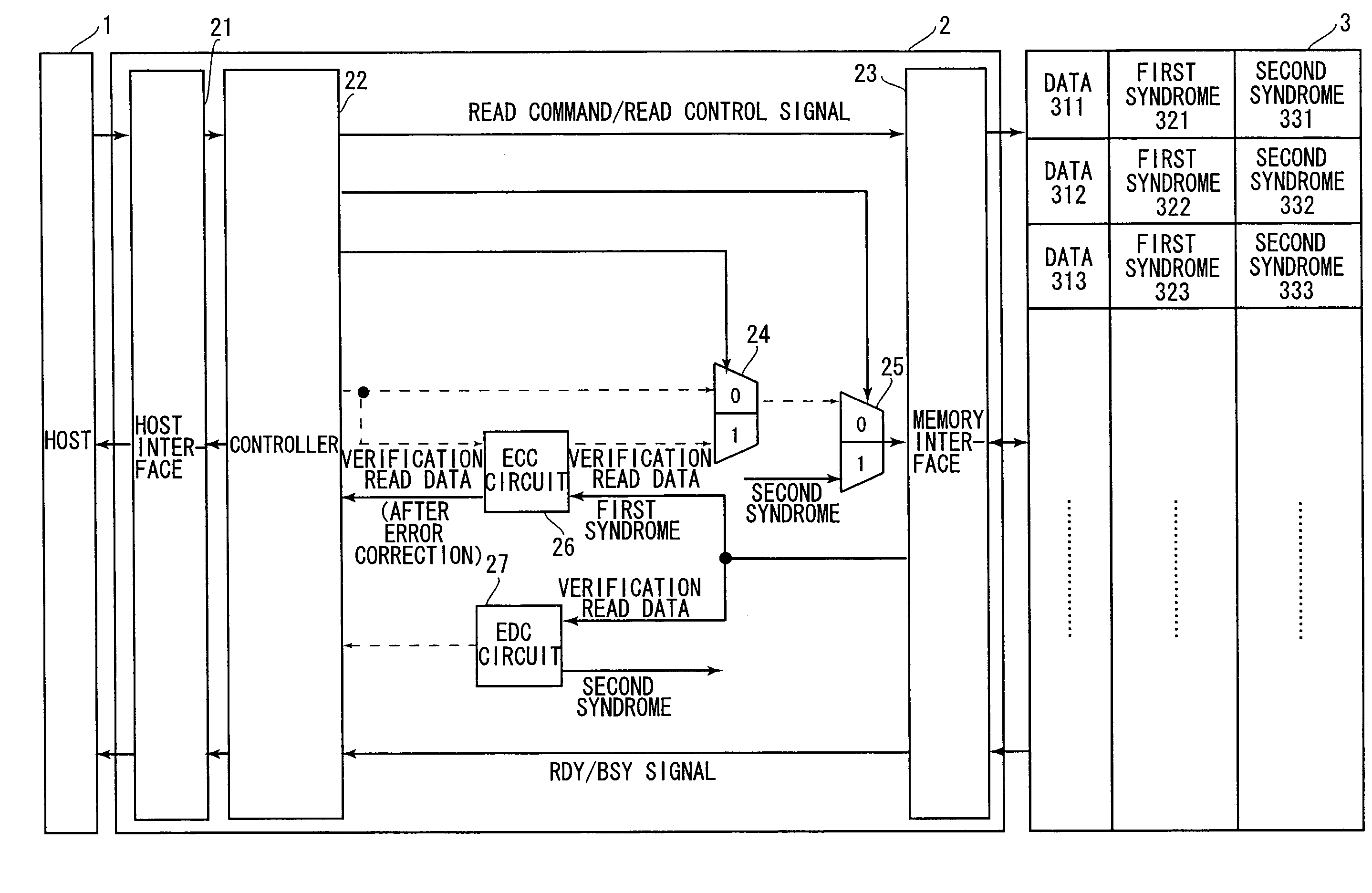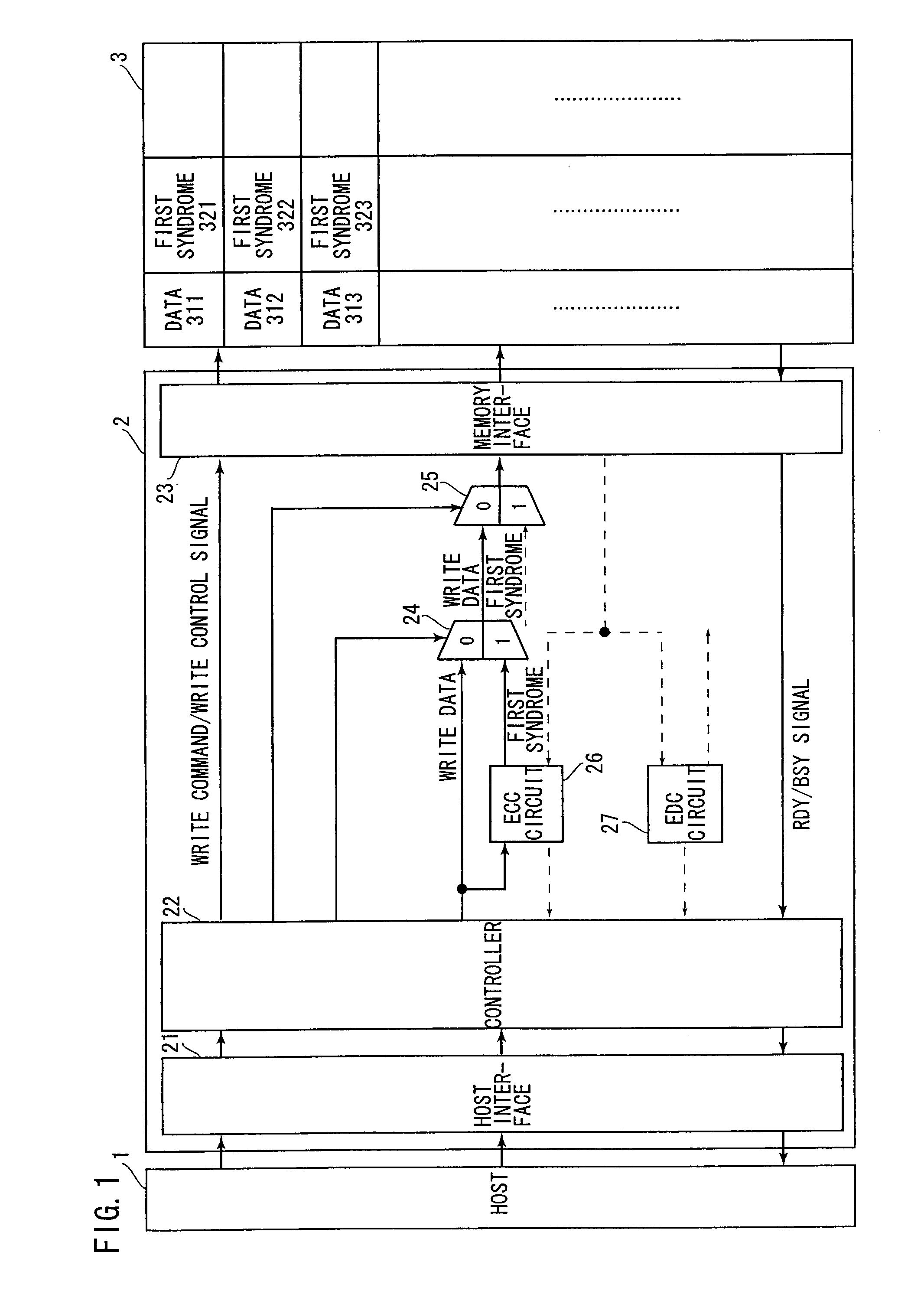Memory access system
- Summary
- Abstract
- Description
- Claims
- Application Information
AI Technical Summary
Benefits of technology
Problems solved by technology
Method used
Image
Examples
first embodiment
[0033]A first embodiment is described as follows with reference to the drawings. First, the components of a memory access system and of a memory are described. Then, the process flows of the memory access system are described in the following order: (1) a writing process flow, (2) a verification reading process flow after the writing, (3) a normal reading process flow, and (4) a refreshing process flow after error detection.
[0034]FIGS. 1, 3, and 5 are block diagrams showing the components of the memory access system and of the memory. FIGS. 1, 3, and 5 also show information exchange in the writing process flow, the verification reading process flow, and the normal reading process flow, respectively.
[0035]The memory access system, which is a system to access a memory 3, is constituted of a host 1 and a memory controller 2 and the like. The host 1 requires the memory controller 2 to write or read data to or from the memory 3. The host 1 also requires the memory controller 2 to inform ...
second embodiment
[0091]A second embodiment is described as follows using FIG. 10. FIG. 10 is a diagram showing an error detection process flow and an error correction process flow according to the second embodiment. The memory controller 2 of the second embodiment differs from that of the first embodiment in having an ECC circuit 28 instead of the ECC circuit 26 and an ECC circuit 29 instead of the EDC circuit 27.
[0092]In the second embodiment, as in the first embodiment, the frequency at which the “program disturb phenomenon” occurs is guaranteed at 4 bits per 512 bytes. The ECC circuit 29 can correct errors of 1 bit per 512 bytes, thereby detecting errors of at least 2 bits per 512 bytes. The ECC circuit 28 can correct errors of 4 bits per 512 bytes.
[0093]The process flows of the second embodiment differ from those of the first embodiment in the error correction process flow (corresponding to Steps S24, S33, and S44). First, the syndrome generation process proceeds as follows. The ECC circuit 28 g...
third embodiment
[0098]A third embodiment is described as follows using FIG. 11. FIG. 11 is a diagram showing an error detection process flow and an error correction process flow according to the third embodiment. The memory controller 2 of the third embodiment differs from that of the first embodiment in having an ECC circuit 30 instead of the ECC circuit 26 and the EDC circuit 27.
[0099]More specifically, in the first embodiment, the ECC circuit 26 and the EDC circuit 27 are composed of different circuit blocks from each other. In the second embodiment, the ECC circuits 28 and 29 are composed of different circuit blocks from each other. In the third embodiment, on the other hand, the ECC circuit 30 is composed of a single circuit block.
[0100]In the third embodiment, in the same manner as in the first embodiment, the frequency at which the “program disturb phenomenon” occurs is guaranteed at 4 bits per 512 bytes. The ECC circuit 30 can correct errors of 5 bits per 512 bytes.
[0101]The process flows o...
PUM
 Login to View More
Login to View More Abstract
Description
Claims
Application Information
 Login to View More
Login to View More - R&D
- Intellectual Property
- Life Sciences
- Materials
- Tech Scout
- Unparalleled Data Quality
- Higher Quality Content
- 60% Fewer Hallucinations
Browse by: Latest US Patents, China's latest patents, Technical Efficacy Thesaurus, Application Domain, Technology Topic, Popular Technical Reports.
© 2025 PatSnap. All rights reserved.Legal|Privacy policy|Modern Slavery Act Transparency Statement|Sitemap|About US| Contact US: help@patsnap.com



